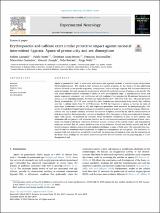Erythropoietin and caffeine exert similar protective impact against neonatal intermittent hypoxia : apnea of prematurity and sex dimorphism
Fecha
2019Autor
Laouafa, Sofien
Iturri, Pablo
Arias-Reyes, Christian
Marcouiller, François
Gonzales, Marcelino
Joseph, Vincent
Bairam, Aida
Soliz, Jorge
Metadatos
Mostrar el registro completo del ítemResumen
Abstract.
Apnea of prematurity (AoP) is associated with severe and repeated episodes of arterial oxygen desaturation (intermittent hypoxia - IH), which in turn increases the number of apneas. So far, there is no data addressing whether IH leads to sex-specific respiratory consequences, neither if drugs targeting AoP are more effective in males or females. We used rat pups for investigating whether IH-mediated increase of apneas is sex-specific. We also tested whether caffeine (treatment of choice of AoP), erythropoietin (Epo - a neuroprotective factor and potent respiratory stimulant), and combination of both (caffeine+Epo) prevent the IH-mediated formation of apneas in a sex-dependent manner. Newborn rats exposed to IH (21% - 10% FIO2-8 h a day - 10 cycles per hour) during postnatal days (P) 3-10 were used in this work. Animals were administered drug vehicle, Epo, caffeine and Epo + caffeine (daily from P3 to P10) gavage. At P10 the frequency of apneas at rest (as an index of respiratory dysfunction induced by IH), and respiratory parameters were measured by plethysmography. Our results showed that IH significantly increases the number of apneas in male but not in female rat pups. Moreover, caffeine and Epo in males similarly prevented the increase of apneas induced by IH, and the administration of both drugs together did not provide a cumulative beneficial effect. No impact of drugs was evidenced in females. Apart from apneas, IH increased the normoxic basal ventilation (ventilation at rest) of male animals, and treatments did not prevent such alteration. Besides, no IH- nor treatment-mediated modulation of basal ventilation was found in the basal ventilation of female animals. Analysis of the activity of pro- and antioxidative molecules revealed that IH induces oxidative stress in the brainstem of male and female animals and that all tested treatments similarly prevented such oxidative imbalance in pups of both sexes. We concluded that neonatal IH and the treatments tested to prevent its respiratory consequences are sex-specific. The mechanics associated with such prevention are directly linked with the prevention of oxidative stress and the maturation of the brain. These findings are relevant to understanding better the AoP disorder and for proposing Epo as a new therapeutical tool.

